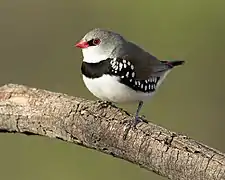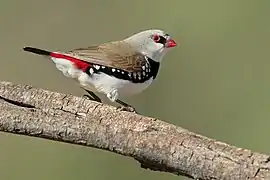Diamond firetail
The diamond firetail (Stagonopleura guttata) is a species of estrildid finch that is endemic to Australia. It has a patchy distribution and generally occupies drier forests and grassy woodlands west of the Great Dividing Range from South East Queensland to the Eyre Peninsula in South Australia. While it is a small stocky bird it is one of the largest finches in Australia. The birds are very distinctive with a black breast-band on a white breast. The flanks are black with white spots and it has a scarlet rump (hence the name) and a black tail.
| Diamond firetail | |
|---|---|
 | |
 | |
| Scientific classification | |
| Domain: | Eukaryota |
| Kingdom: | Animalia |
| Phylum: | Chordata |
| Clade: | Dinosauria |
| Class: | Aves |
| Order: | Passeriformes |
| Family: | Estrildidae |
| Genus: | Stagonopleura |
| Species: | S. guttata |
| Binomial name | |
| Stagonopleura guttata (Shaw, 1796) | |
Taxonomy
The family Estrildidae (grass-finches) was named by Swainson in 1827 and "finch" can be traced back to the Old English finc but its origin is debated. Firetail is now used to describe the three species of Stagonopleura. The red-browed finch (Neochmia temporalis) is no longer considered a firetail even though it has a red rump.[2]
The diamond firetail has also been known as the "spotted finch (Lewin 1808), spotted grossbeak (Lewin 1822), spotted-sided grossbeak (Latham 1823) and spotted- finch (Gould 1848)". The name diamond firetail was first used in the Royal Australian Ornithological Union (RAOU's) second official checklist in 1926.[2] Stagonopleura, is from the Greek for 'spotty flanks' and guttata from the Latin gutta, a 'droplet'.
Description
The diamond firetail is one of the largest of the Australian finches by both weight (15–19 g) and wingspan (64–71 mm).[3] eBird describes the firetail having an olive back and grey head. The belly and throat are white with a complete black band. The flanks are black with distinctive white spots. The rump is bright red and the tip of the tail is black.[4] The rump is also described as scarlet by some authors.[3] Juvenile diamond firetails are duller than the adults and have a black bill.
The rump is very distinctive in flight. These birds are generally seen in pairs or small flocks, sometimes up to a hundred birds. The birds fly low and in long lines.[3][5]
Distribution and habitat
The diamond firetail has a patchy distribution from Southeast Queensland to the Eyre Peninsula in South Australia.[4] The Australian Bird Guide shows its core distribution from southern Queensland (just north in Inglewood) through to Victoria and around the coast to the Eyre Peninsula in South Australia and the eBird distribution is similar.[3] Birdlife Australia has a more extensive distribution from the Carnarvon Ranges in Queensland to the Eyre Peninsula and Kangaroo Island which is broader than other references.[5] This broader distribution reflects the historic range of the bird based on the surveys done for The Atlas of Australian Birds.[6] The species was recorded as far north as the Kirrama Tableland in North Queensland in 1917, as a "new record for the district".[7]
The bird is mostly sedentary and lives in open grassy eucalypt forest and woodland, heath, mallee country, farmland and grassland with scattered trees. The bird's habitat has been threatened by alteration of vegetation structure caused by over-grazing, weed invasion, salinisation and other flow-on processes. This loss of main food plants and habitat results in competition with invasive species, and increased predation.[5]
Behaviour
Feeding
Diamond firetails are ground feeders with a diet of grass seeds; ripe or partially ripe. They have also been observed eating insects and larvae. While feeding they will be seen hopping on the ground but if disturbed they will fly into nearby trees.[5]
Vocalisation
The Slater Field Guide notes the voice is a penetrating twoo-hee or pain, while the Australian Bird Guide describes the contact call as a "drawn out, mournful whistle like descending call of black-eared cuckoo, though typically disyllabic, with first syllable ascending and second descending". They are generally silent in flight.[3][8]
Reproduction
Nests are built with green grass, leaves and stems then lined with feathers and fine grasses. Nests can be found in dense foliage such as "hakeas, rose bushes, boxthorn and the sharp-sounding Sea Urchin Hakea" and high in trees including within mistletoe and babblers' nests. It has also been known to build in hawks' nests. Birdlife Australia records "To safeguard their eggs and nestlings, diamond firetails are often recorded building their nests into the base of the large stick-nest of a bird of prey, such as a whistling kite, white-bellied sea-eagle, wedge-tailed eagle, brown falcon, nankeen kestrel or a square-tailed kite. One nest of a whistling kite contained nine diamond firetail nests!"[5]
The incubation and care for the young is done by both partners. Normally only one clutch of between 4 and 9 eggs is laid per season.[5][8]
Status and conservation
- Internationally
- * The species is listed under the IUCN Red List of Threatened Species as a species of Vulnerable.[1]
- Australia
- * The species is nationally listed as Vulnerable under the EPBC Act.[9]
- * In NSW, it is listed as Vulnerable under the Biodiversity Conservation Act 2016.[10]
- * In Queensland, the species is listed as Vulnerable under the Nature Conservation (Animals) Regulation 2020.[9]
- * In South Australia, the species is listed as Vulnerable under the National Parks and Wildlife Act 1972.[11]
- * In Victoria, the species is listed as Vulnerable under the Flora and Fauna Guarantee Act 1988.[12]
Aviculture
The striking plumage of the diamond firetails make them popular in aviculture. However, they are not particularly suited for inexperienced keepers as they are hard to breed, are assertive in behaviour, and are difficult to sex. In some Australian states, strict licensing requirements apply.[13]
Gallery
- Sundown NP, S Queensland, Australia
 Lewin- spotted grossbeak 1819
Lewin- spotted grossbeak 1819 Stagonopleura guttata, John Gerrard Keulemans, 1873
Stagonopleura guttata, John Gerrard Keulemans, 1873_(31292986502).jpg.webp) Diamond firetail feeding
Diamond firetail feeding Auburn Botanical Gardens, NSW
Auburn Botanical Gardens, NSW
References
- BirdLife International (2022). "Stagonopleura guttata". IUCN Red List of Threatened Species. 2022: e.T22719660A211542365. Retrieved 28 July 2022.
- Fraser, Ian; Gray, Jeannie (2019). Australian Bird Names: Origins and Meanings. Clayton South, Vic: CSIRO Publishing. pp. 31–32, 37. ISBN 9781486311637.
- Menkhorst, Peter; Rogers, Danny; Clarke, Rohan; Davies, Jeff; Marsack, Peter; Franklin, Kim (2017). The Australian Bird Guide. Clayton, Vic: CSIRO Publishing. pp. 296–297. ISBN 978-0643097544.
- "Diamond Firetail – eBird Australia". ebird.org. Retrieved 31 May 2022.
- Birdlife Australia. "Diamond Firetail | BirdLife Australia". www.birdlife.org.au. Retrieved 1 June 2022.
- Blakers, M.; Davies, S.J.J.F.; Reilly, P.N. (1984). The Atlas of Australian Birds. Melbourne: Melbourne University Press. p. 592. ISBN 0522842852.
- Campbell, A.J.; Barnard, H.G. (1917). "Birds of the Rockingham Bay District, North Queensland". Emu. 17: 35.
- Slater, Peter; Slater, Pat; Slater, Raoul (2009). The Slater Field Guide to Australian Birds (2nd ed.). London, Sydney, Auckland: Reed New Holland. pp. 210–211. ISBN 9781877069635.
- "Stagonopleura guttata — Diamond Firetail". Department of the Environment. Retrieved 13 August 2023.
- "Diamond Firetail - profile". NSW Office of Environment & Heritage. Retrieved 13 August 2023.
- "National Parks and Wildlife Act 1972" (PDF) (PDF). Department for Environment and Water (South Australia). 21 June 2023. Retrieved 13 August 2023.
- "Flora and Fauna Guarantee Act 1988 - Threatened List" (PDF) (PDF). Department of Energy, Environment and Climate Action. June 2023. Retrieved 13 August 2023.
- "Diamond Firetail Finch – Aviculture Hub". 10 March 2017. Retrieved 1 June 2022.
- "Diamond Firetail Finch – Emblema guttata, Stagonopleura guttata". www.finchinfo.com. Retrieved 1 June 2022.
- "Diamond Firetail Finch Facts, As Pets, Care, Feeding, Pictures". Singing-Wings-Aviary.com. 31 December 2014. Retrieved 1 June 2022.
External links
- BirdLife International species factsheet
- Birds in Backyards – Birdlife Australia
- Description and care (archived) – Doug Hill & Marcus Pollard
- Description and aviary notes – BirdCare.com.au
